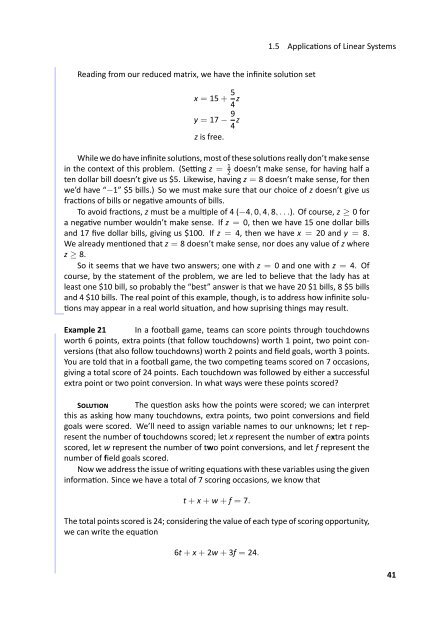Fundamentals of Matrix Algebra, 2011a
Fundamentals of Matrix Algebra, 2011a
Fundamentals of Matrix Algebra, 2011a
Create successful ePaper yourself
Turn your PDF publications into a flip-book with our unique Google optimized e-Paper software.
1.5 Applicaons <strong>of</strong> Linear Systems<br />
Reading from our reduced matrix, we have the infinite soluon set<br />
x = 15 + 5 4 z<br />
y = 17 − 9 4 z<br />
z is free.<br />
While we do have infinite soluons, most <strong>of</strong> these soluons really don’t make sense<br />
in the context <strong>of</strong> this problem. (Seng z = 1 2<br />
doesn’t make sense, for having half a<br />
ten dollar bill doesn’t give us $5. Likewise, having z = 8 doesn’t make sense, for then<br />
we’d have “−1” $5 bills.) So we must make sure that our choice <strong>of</strong> z doesn’t give us<br />
fracons <strong>of</strong> bills or negave amounts <strong>of</strong> bills.<br />
To avoid fracons, z must be a mulple <strong>of</strong> 4 (−4, 0, 4, 8, . . .). Of course, z ≥ 0 for<br />
a negave number wouldn’t make sense. If z = 0, then we have 15 one dollar bills<br />
and 17 five dollar bills, giving us $100. If z = 4, then we have x = 20 and y = 8.<br />
We already menoned that z = 8 doesn’t make sense, nor does any value <strong>of</strong> z where<br />
z ≥ 8.<br />
So it seems that we have two answers; one with z = 0 and one with z = 4. Of<br />
course, by the statement <strong>of</strong> the problem, we are led to believe that the lady has at<br />
least one $10 bill, so probably the “best” answer is that we have 20 $1 bills, 8 $5 bills<br />
and 4 $10 bills. The real point <strong>of</strong> this example, though, is to address how infinite solu-<br />
ons may appear in a real world situaon, and how suprising things may result. .<br />
. Example 21 .In a football game, teams can score points through touchdowns<br />
worth 6 points, extra points (that follow touchdowns) worth 1 point, two point conversions<br />
(that also follow touchdowns) worth 2 points and field goals, worth 3 points.<br />
You are told that in a football game, the two compeng teams scored on 7 occasions,<br />
giving a total score <strong>of</strong> 24 points. Each touchdown was followed by either a successful<br />
extra point or two point conversion. In what ways were these points scored?<br />
S The queson asks how the points were scored; we can interpret<br />
this as asking how many touchdowns, extra points, two point conversions and field<br />
goals were scored. We’ll need to assign variable names to our unknowns; let t represent<br />
the number <strong>of</strong> touchdowns scored; let x represent the number <strong>of</strong> extra points<br />
scored, let w represent the number <strong>of</strong> two point conversions, and let f represent the<br />
number <strong>of</strong> field goals scored.<br />
Now we address the issue <strong>of</strong> wring equaons with these variables using the given<br />
informaon. Since we have a total <strong>of</strong> 7 scoring occasions, we know that<br />
t + x + w + f = 7.<br />
The total points scored is 24; considering the value <strong>of</strong> each type <strong>of</strong> scoring opportunity,<br />
we can write the equaon<br />
6t + x + 2w + 3f = 24.<br />
41

















